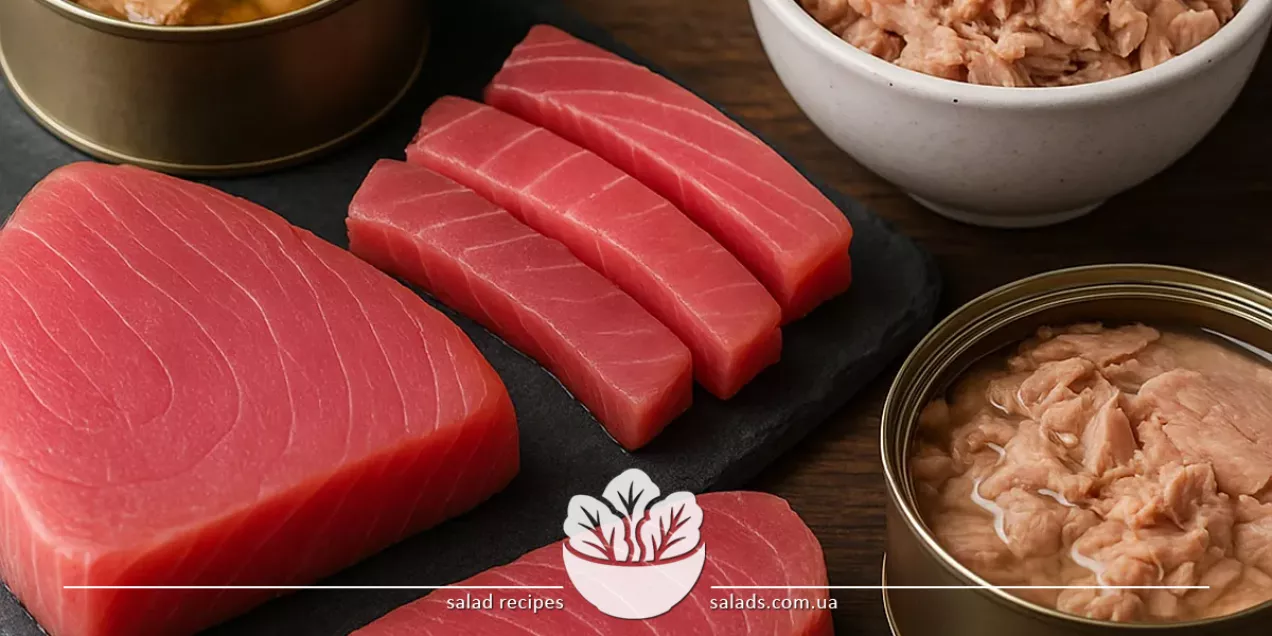Tuna

Tuna is a predatory marine fish valued for its tender texture, rich protein composition, and versatility in cooking. Its flesh is deep reddish in color, firm in texture, and contains minimal small bones. Tuna is especially popular in Mediterranean, Japanese, and American cuisines but is also widely used in everyday cooking worldwide. Within the fish category, tuna stands out as an ingredient suitable for both raw consumption and thermal processing, such as in steaks or canned form.
Different Types of Tuna
Fresh Tuna: Restaurant Quality in Home Cooking
Fresh tuna is considered a delicacy, especially prized for its dense, nearly meaty texture, rich flavor, and high nutritional value. Fresh tuna fillets have a distinctive dark pink or red color, no small bones, and require little processing. As a result, tuna is widely used in gourmet cuisine, particularly for steaks, tartare, sushi, and sashimi. In home cooking, fresh tuna can be grilled, seared on both sides to medium rare, stewed with vegetables, or served raw. It doesn’t need many spices – olive oil, lemon juice, sea salt, and a bit of pepper are enough. When paired with light side dishes like vegetables, leafy greens, acidic sauces, or grains, tuna reveals its deep flavor. For instance, a tuna steak can be served with boiled rice and flavorful salsa.
As a predatory fish, tuna meat is rich in protein, omega-3 fatty acids, B vitamins, iron, and phosphorus. It also contains very little fat, making it popular among those who follow a healthy lifestyle or a sports diet. Thanks to its density, tuna meat maintains its shape during any cooking method, doesn’t fall apart, and looks attractive on the plate. Fresh tuna is most often served as a main course or part of sophisticated gastronomic compositions. It pairs well with Mediterranean herbs, garlic, capers, lemon, and tomatoes, allowing for bright and well-balanced dishes.
Canned Tuna: A Versatile Ingredient for Quick Meals
Canned tuna is one of the most convenient and popular ways to use this fish in everyday cooking. It is sold in its own juice, in oil, or with spices, either shredded or in chunks. Thanks to its long shelf life and ready-to-eat format, canned tuna is widely used in salads, sandwiches, spreads, and hot dishes. One of its main advantages is its versatility: it pairs well with vegetables, eggs, cheese, and sauces based on mayonnaise or yogurt. For example, a classic salad with tuna, egg, and avocado is a hearty yet light dish that can be prepared in minutes. Tuna is also great in pasta, fish cakes, tartlets, casseroles, or as a filling for crepes.
In canned form, tuna retains most of its nutritional properties: complete protein, B vitamins, selenium, phosphorus, and magnesium. It contains no unnecessary additives and is considered one of the purest sources of protein among long-shelf-life products. It is also easy to portion – one can usually holds about 100-200 g of ready-to-eat product, which is ideal for one or two servings. Canned tuna is the perfect choice for those who value quick preparation, quality, and nutritional density. Thanks to its mild flavor, it serves as a great base for creative recipes – from bread spreads to Asian bowls or Mediterranean dishes. This product easily fits into both everyday meals and more sophisticated culinary combinations.
Tuna for Sushi and Sashimi: Quality, Freshness, and Proper Handling
Tuna is one of the most essential ingredients in Japanese cuisine, especially in sushi and sashimi. Specific parts of the fish are used for these dishes, mainly the “bluefin” variety, which features deep coloration, dense structure, and high protein content. For raw dishes, freshness and quality are crucial – sushi-grade tuna must be chilled (not frozen), cut in controlled conditions, and processed according to food safety standards. In sashimi, tuna fillets are served in thick slices, unseasoned – only with soy sauce, wasabi, and pickled ginger. In sushi, it is laid over rice, usually in the form of nigiri or rolls. In such dishes, tuna reveals its natural, slightly sweet flavor, while its firm texture contrasts nicely with soft rice. For example, a roll with tuna, cucumber, and pineapple creates a bright flavor play – from meatiness to fresh acidity.
Besides bluefin, sushi may also feature yellowfin tuna, which has lighter meat and a more delicate flavor. It is prized for its ability to pair harmoniously with creamy or spicy sauces and vegetable ingredients. In modern culinary interpretations, tuna may be chopped for tartare, added to bowls, or combined with fruits and microgreens. Tuna for sushi is not just a fish but a cultural element. Proper preparation includes slicing the fillet at a specific angle, storing it at 0-2 °C, and avoiding contact with metal surfaces, which may affect the flavor. Only under these conditions can tuna fully express its culinary potential in raw dishes.
Tuna Steaks: A Modern Alternative to Red Meat
Tuna steaks are increasingly appearing in both restaurant and home kitchens as an alternative to beef or pork. Thanks to its texture and density, tuna fillets are easy to cut into 2-3 cm thick steaks that can be quickly seared in a pan or grilled. This format helps retain juiciness inside and form an appetizing crust on the outside – similar to cooking a meat steak. Tuna steaks should be cooked with care: they are best not fully cooked. The optimal doneness is medium rare or medium, where the center remains pink and juicy. This preserves not only flavor and aroma but also valuable nutrients. As a result, tuna remains a light, diet-friendly, and highly nutritious main dish component.
Tuna steaks pair well with aromatic herbs, lemon, garlic, wholegrain mustard, and light side dishes. They are especially tasty with vegetable purées, fresh vegetable salads, or grain-based garnishes. For example, a tuna steak with a mix of greens and herring fillet in sauce or spread form is an unusual but rich flavor combination. With minimal fat, tuna steaks are easy to digest, do not feel heavy, and are suitable for evening meals. They are often included in the diets of people reducing red meat consumption or looking for lighter dietary options. In restaurants, such steaks are often served with sweet-and-sour or spiced sauces made from fruit, wine, balsamic vinegar, or ginger.
Nutritional Value of Tuna: Protein, Micronutrients, and Health Benefits
Tuna is one of the richest sources of animal protein: 100 g of fillet contains up to 25 g of protein with a complete amino acid profile. With low fat (especially when fresh) and no carbohydrates, tuna is an ideal choice for dietary, athletic, or balanced eating. It is easily digestible, quickly promotes satiety, and supports muscle mass, which is important for both active individuals and those on a low-calorie regimen. Besides protein, tuna contains important micronutrients: selenium, phosphorus, magnesium, potassium, iron, and B vitamins – especially B3, B6, and B12. These nutrients support healthy metabolism, improve cardiovascular, nervous, and immune system functions, and maintain energy balance. The omega-3 fatty acid content varies by species – fattier types offer added anti-inflammatory benefits and improve vascular health.
Thanks to these properties, tuna is recommended in nutritional science, especially for athletes, children, the elderly, and pregnant women. For example, canned tuna combined with cheese and fresh vegetables makes a nutritious breakfast or a light dinner. This combination provides not only protein but also calcium, fiber, and healthy fats. In healthy eating, it’s important to consider the fish’s origin and processing method. Choose sustainably sourced tuna that’s free from excessive preservatives or salt. In any form – fresh, steak, canned, or tartare – tuna remains one of the most nutrient-rich foods in the modern diet.
